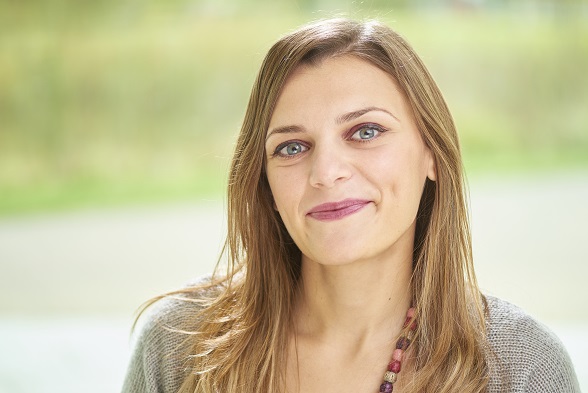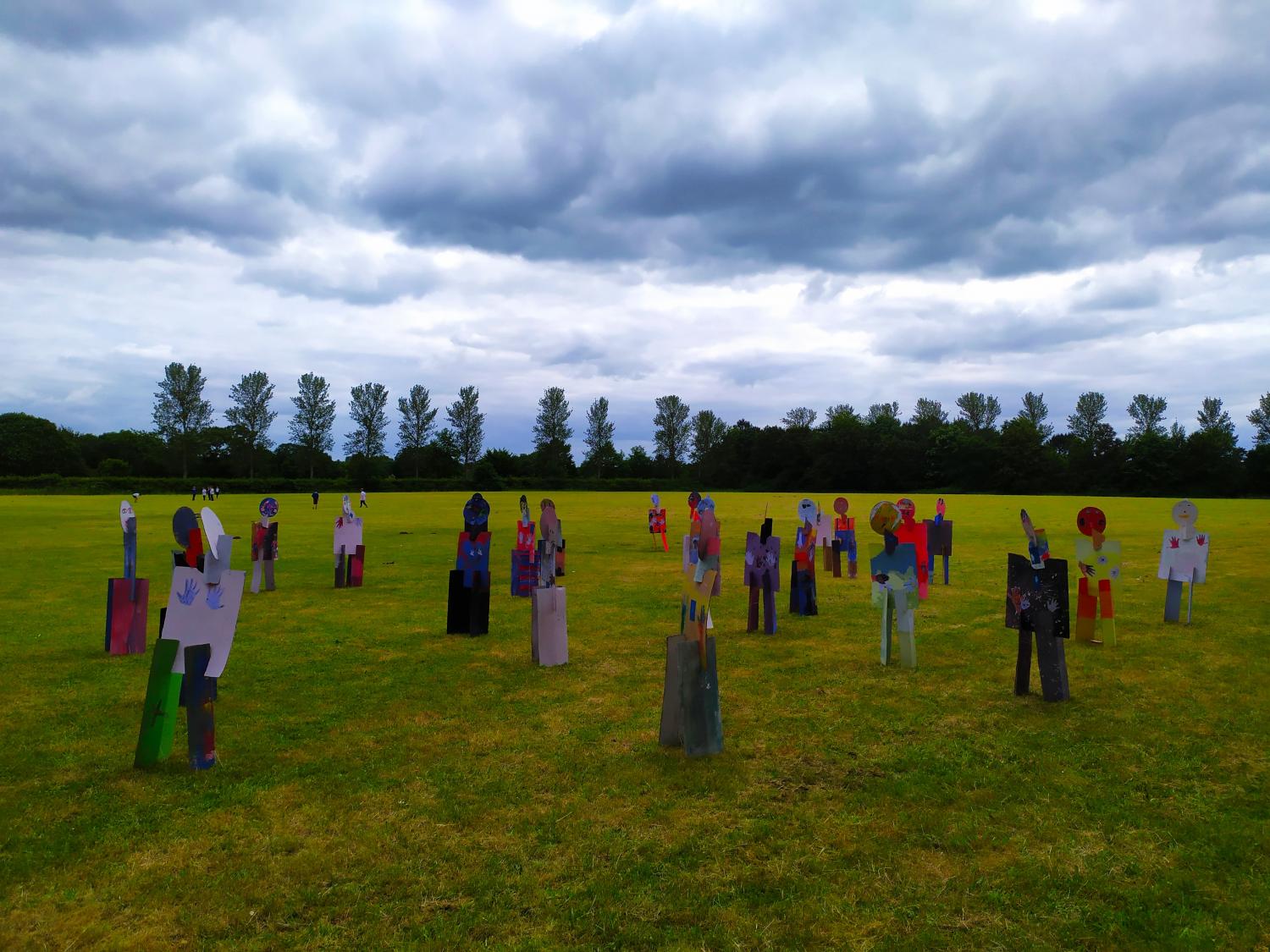January 28th, 2025
Topics
Research in Conversation
The role of art during the climate crisis: An interview with Dr. Zoe Moula
Zoe Moula is a Lecturer in Mental Health at the Department of Care in Long-Term Conditions at King’s College London. Her work is focused on how art therapy, including arts-in-nature, impacts the well-being of children and youth. Dr. Moula visited the Research Institute for Humanity and Nature in October of 2024 as a guest lecturer.
 Dr. Zoe Moula
Dr. Zoe Moula
In the 2022 paper, “Eco-Capabilities as a Pathway to Wellbeing and Sustainability,” Dr. Moula et al. documented findings after a group of children aged seven to ten years old in a low-income area of eastern England participated in arts-in-nature programming for eight days. Participants benefited in a variety of ways, including emerging with a stronger sense of their connectedness to nature and to each other, their autonomy and sense of self, their well-being, and their creativity. The article can be read here.

I had the privilege of interviewing Dr. Moula about her work. I wanted to learn more about the importance of art for individuals’ well-being and education during a time of environmental crisis.
To begin, Dr. Moula made it clear that art is not confined to a museum and everyone can and should be an artist.
“Artists are able to see beauty in every detail to the point that it changes their perspective on how they view things in life in general...Especially in difficult times, to be able to find the beauty in things around you, is quite a useful coping mechanism to have.”
Dr. Moula continued: “I see my work as art. The creative writing that is a part of my work is art.”
With such a perspective, going into the office feels a lot less drab. There is so much room for beauty in the work we do and in everyday life.
I asked: “What do you see as the importance of your work in the climate crisis? How are the arts a part of the solution to addressing big environmental problems –– as much as science or policy is a part of that solution?”
Dr. Moula: “The main problem with the ecological crisis is that it’s so vast and abstract. And, especially for some people who’ve not been directly affected, for example children in the UK or in London, chances are they have not realized the impacts of climate change on their life. But the arts can make something that is so far away, that doesn’t affect your life, become a bit more real. Maybe it can be through images of other people and how it has affected their life; maybe there is an exhibition or a song about it. But the arts narrow it down a little bit to something a child can understand, especially if they don’t have direct experience. Because climate change is such a vast and complex thing, we often don’t know how we feel about it. Often just by being able to express ourselves through arts –– music, dance, or theater, for example –– we can process what is going on in our mind, process our emotions, process all of the knowledge that we have into something that may give us a sense of what we’re thinking of and going through...”
Dr. Moula makes two important points. First, the arts can be a vehicle for learning, including learning about climate change, in an approachable way. The arts can welcome more people into the conversations surrounding the climate crisis –– for example, people who may be unfamiliar with the science or who’ve yet to knowingly experience the impacts of climate change –– and, in this way, can be a powerful tool for increasing public attention to the issue. Second, the arts can also be a tool for the feeling and processing that has to happen to come to a deeper understanding of a complex issue such as climate change.
A 2023 study by the Yale Program on Climate Change Communication found that 64% of adults in the United States are worried about global warming. Another study from the same year found that about one in ten adults in the United States may be experiencing anxiety because of climate change. Similar surveys can be found across different countries and contexts. Given this, I wanted to better understand the roles the arts and art therapy can play in addressing eco-anxiety, or chronic worrying about environmental harm due to climate change and its associated impacts in one’s lifetime and on the lives of future generations.
Dr. Moula: “Eco-anxiety is viewed as a healthy response to the climate crisis. It’s not like anxiety that you want to try and reduce...With eco-anxiety it is absolutely an appropriate response. Therapists would try and manage how to live with it, in ways that are more productive –– maybe just thinking of what you could do, or connecting with other people who have similar concerns and collectively you could create change.”
So eco-anxiety is, for some, simply a natural product of living during a time of environmental crisis: what’s important is that this deep concern leads not to despair, but to action, processing, connection, and understanding. Dr. Moula thinks the arts can help with this.
Dr. Moula: “This is where I see the arts coming into play. This links quite well with a project I’m doing with the World Health Organization (WHO). We’re trying to understand what is the role of the arts in, first of all, communicating and raising awareness about climate change; secondly, in adapting to it, and creating resilience for the communities that are affected and those who are not affected yet; and, finally, in terms of mitigating climate change and actually doing something about it...”
“What’s interesting is that a lot of artwork that exists is catastrophic in nature, it can feel a bit horrifying...this is not productive artwork because it makes people feel even more distant than they already feel. So we are working now to try and understand what are the features of artwork that would not make you feel horrified about even talking about this topic of climate change, but to actually think ‘maybe I can start to comprehend some things about the complexity of the topic and maybe there is something I can do about it.’ ...So there’s a huge role that the arts can play and we’re just trying to pick out the mechanism by which this is happening and what would be more effective in the future to achieve the benefits that we want to see when it comes to addressing the ecological crisis.”
In this WHO project, Dr. Moula’s role is to put together an evidence synthesis of what we know about effective climate-related art. I was curious to hear about any interesting findings thus far. Dr. Moula shared that what has “been useful is if artwork is not displayed in places like museums or art galleries because, for many people, this is seen as an elite type of place... We’ve found it’s more effective if there are artist exhibitions or performances that are in outdoor public spaces...Otherwise what happens [with a museum exhibition] is you’re targeting the people who are already interested in the arts or the environment.”
So, to draw some of this together, the arts serve many important functions in this time of environmental crisis and beyond: the arts can be an educational tool and a tool for processing, feeling, and reflecting; the arts can translate into action and are a part of the solution; and the arts can improve personal well-being and connection to nature, as Dr. Moula has found in her work with children in the U.K. Given such benefits, I wanted to understand a low-barrier pathway to increasing childhood experiences with arts and nature.
“Is there a particular arts activity that every elementary school teacher in Japan, in the U.K., in the U.S., or elsewhere, could do with their kids that would be very beneficial?” I asked.
Dr. Moula: “I think very simple activities like going outside for 15 minutes a day and saying ‘we’ll be noticing nature today’, and maybe they can create the simplest drawing out of that experience. But just take this moment to appreciate what is around us...Give children the chance to just ‘be’ and notice, even without doing anything. They can just look and stare at the trees. That is art. Having the time to ‘be’ is what is missing for a lot of children in schools where it’s often focused on tests.”
Art can be as simple as the act of noticing.
Anna Lenaker is an in-house science writer and storyteller at the Research Institute for Humanity and Nature (RIHN). She is a visiting researcher through June 2025 and Luce Scholar, funded by the Henry Luce Foundation. At RIHN, she is committed to translating research findings and their importance to different audiences; sharing methodologies, ideas, and insights from RIHN to the world; and capturing the stories around environmental issues and research. Anna recently completed her Master of Environmental Management at the Yale School of the Environment, specializing in climate change science and solutions, as well as water resource science and management. Before this, she received her Master of Public Affairs and Bachelor of Arts in Religious Studies from Brown University.